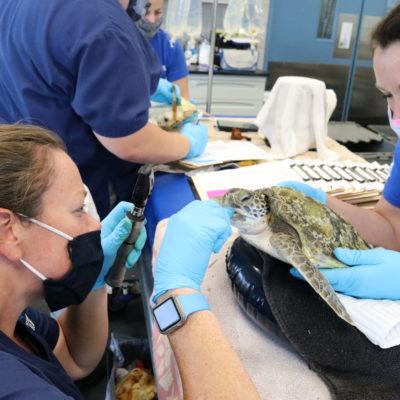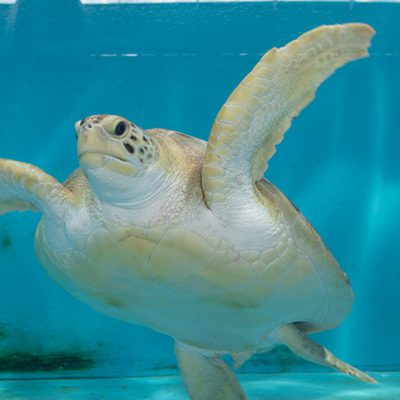Press Room
Tampa, FL (May 31, 2023): For the first time ever, offspring of the threatened Atlantic pillar coral (Dendrogyra cylindrus), produced from spawning using lab-induced techniques and raised in an aquarium, have made their way back into waters of the Florida Keys National Marine Sanctuary. Born in The Florida Aquarium’s induced spawning lab in 2020, these pillar coral offspring were painstakingly cared for by the Aquarium’s conservation biologists in preparation for this important day. The corals were delivered to the Coral Restoration Foundation in Key Largo, for immediate transport to their new home in an ocean-based nursery, where they will be continually monitored and grown out for further reef restoration efforts.
This is a significant step toward preventing the local extinction of pillar coral in Florida, as scientists believe this species has not successfully produced living offspring on its own in Florida for decades. Pillar corals on Florida’s Coral Reef were decimated by the outbreak of stony coral tissue loss disease. Today, scientists studying the remaining population report only 24 genetic individuals remain alive on Florida’s Coral Reef, and declared the species “functionally extinct”, meaning that natural recovery through reproduction would not occur without human intervention. Although pillar coral colonies were historically low in abundance, it is an iconic species well known to divers and is the only coral species in the Atlantic that forms vertical cylindrical columns, similar to large clumps of vertical fingers.
“We have been waiting for four years to finally be able to return a few pillar coral offspring to the ocean. These five corals are the first new genotypes of pillar coral to enter the Florida population in decades. We came very close to losing this species in Florida, but through collaboration and world-class aquarium care, we are now able to take the first steps toward rebuilding the population for the future.” said Keri O’Neil, The Florida Aquarium’s Coral Conservation Program Director and Senior Scientist.
The first fragments of pillar coral collected from Florida’s Coral Reef arrived at The Florida Aquarium in 2016 as part of a first-of-its kind coral rescue project that was enacted to save coral colonies from disease. Since that time, the Florida Coral Rescue Project led by the Florida Fish and Wildlife Conservation Commission and NOAA Fisheries, has rescued over 2,300 corals that now reside in 25 aquarium facilities across the United States. The majority of the corals, including those at The Florida Aquarium, are held at facilities accredited by the Association of Zoos and Aquariums (AZA).
In 2019, the pillar coral was the first species to successfully spawn in The Florida Aquarium’s lab. Coral biologists spent months mimicking the natural environment of corals using advanced technology to reproduce the timing of sunrises, sunsets, moonrises and moonsets to trigger the animals to spawn. Today, 14 different species of Atlantic Coral have spawned at The Florida Aquarium. Millions of coral larvae have been shared with partners around the country and thousands of genetic individuals have been outplanted on the reef. And now, The Florida Aquarium is sharing this unique skill set and critical technology with students and practitioners with the ultimate goal of achieving the needed scale for reef restoration.
The threats to the Reef require innovative science and human intervention to save critically endangered corals, like the pillar coral. The young pillar corals produced at The Florida Aquarium, now being given to the Coral Restoration Foundation, came from 19 different parent colonies, 18 of which are no longer alive in the wild. With new combinations of genes from multiple parents, it is possible for the young corals to be more resilient to future stressors.
With reproductive success four consecutive years (the 2023 spawn of this species comes later in the year), the team is cautiously optimistic. However, ultimately the future of Florida’s Coral Reef, and the pillar coral, will depend on further action to prevent climate change and to reduce coastal pollution, which will take significant time. In the meantime, it is important to prevent extinction and to learn the best techniques to produce diverse and resilient corals for the future.
“It’s an honor for Coral Restoration Foundation™ to be part of this pivotal conservation milestone,” said Phanor Montoya Maya, Restoration Program Manager at Coral Restoration Foundation™. “We are thrilled to welcome these unique pillar coral offspring into our ocean-based nursery, enhancing our genetic diversity, a crucial aspect of restoration work. With our expertise, we’re ready to provide these pillar corals with the specialized care they need to thrive. This kind of collaborative work is critical if we are to be successful in repopulating Florida’s Coral Reef with the species that once thrived here. Together, we’re charting a hopeful path for Florida’s pillar coral”.
Support for the pillar coral care and breeding efforts was graciously provided by the Paul G Allen Family Foundation, the National Fish and Wildlife Foundation, the NOAA Coral Reef Conservation Program and Office of Protected Resources, and the Florida Fish and Wildlife Conservation Commission. All activities were conducted under permit by the Florida Keys National Marine Sanctuary and the Florida Fish and Wildlife Conservation Commission.
Contact The Florida Aquarium communications@flaquarium.org
More
to Sea

Florida Aquarium Rallies for Endangered Sea T...
It was a record-setting event for The Florida Aquarium when the team of animal care professionals admitted 17 sea turtles to the Sea Turtle Rehabilitation Center at the Center for Conservation campus ...
Read More
Threatened Green Sea Turtle Makes New Home at...
In 2016, The Florida Aquarium’s animal care team took in Banner, a threatened green sea turtle. After four years of rehabilitation and care, Banner has successfully made the 600-mile trek up the Gul...
Read More